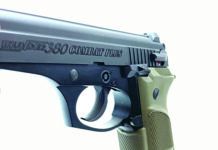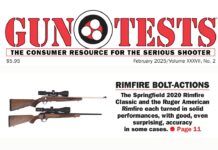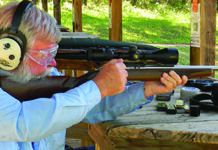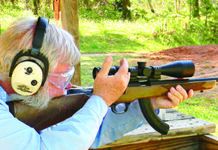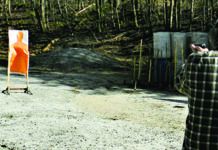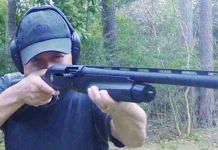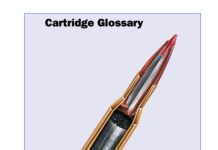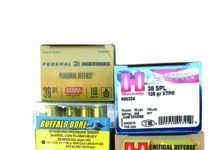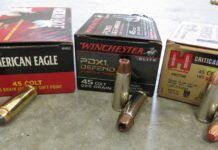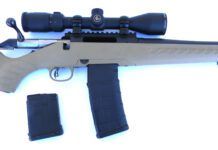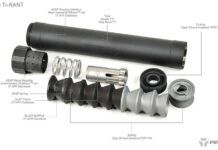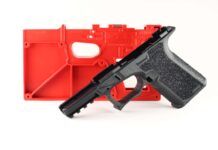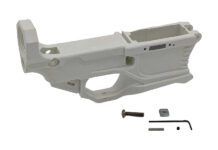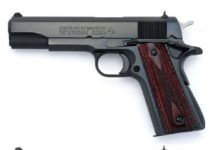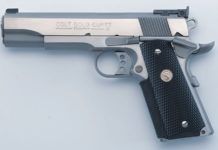Colt Versus Colt 45s: Series 70 Competes Against the 1991A1
When other makers put market pressure on Colt by introducing a bevy of inexpensive 1911A1 handguns, Colt responded with the 1991A1, replacing the expensive Colt high-polish bluing with a matte finish. Walnut grips were deleted in favor of plastic or rubber, although recent Colt 1991A1 production features good-quality wood-grip panels. Features these more affordable 1991A1-Colt pistols kept were the flat mainspring housing and long style trigger of the original 1911 handgun. The usually accepted justification for having a flat mainspring housing is that it is easier to fit a custom-grade beavertail safety. The 1991A1 also featured a scalloped ejection port and sights that are an improvement over GI-model handguns. There was no full-length guide rod, so the pistol was easily field stripped. In the eyes of many, Colt successfully turned out a basic 1991A1 that was affordable for those who would prefer to own a Colt rather than other brands.
However, there was a bone of contention concerning the 1991A1. If a company is going to make institutional LE or other agency sales in this century, the pistol must have a firing-pin lock or drop safety. The Series 80 firing-pin block used in the 1991A1 adds four parts in comparison to the Series 70. The parts are the frame-mounted trigger-bar lever and plunger and the slide-mounted firing-pin plunger and driving spring. Simplicity must be better for reliability, some said. The firing-pin block keeps the firing pin in place until the trigger reaches its rearward travel maximum and releases the firing-pin block and the firing pin. Also, shooters soon learned that care must be taken in disassembly and reassembly with this design so that the plunger is not damaged.
Why was the firing-pin block introduced? If the 1911 handgun were dropped on the muzzle from a sufficient height, the inertia of the firing pin could take a run forward against spring pressure and crack the primer, firing the pistol. This problem is not unique to the 1911; many pistol designs have been updated with firing-pin blocks. Some makers solve the problem with a lightweight firing pin and heavy-duty firing-pin spring. In fact, Para Ordnance (now Para USA) and SIG use the Series 80 firing-pin lock by license. Once Beretta and SIG incorporated the firing-pin block in production, competitors had to follow the same path in order to compete in the law-enforcement market. Even though the majority of accidental discharges are negligent rather than accidental and are caused by shooter error, the firing-pin block is here to stay in the 1991A1. And therein was the problem for many Colt fans.
In short, they feel that Colt ruined the trigger action by adding the drop safety, and that the resulting Series 80 designation was inferior to the Series 70. Others felt that the assembly could lead to problems if it malfunctioned. The fact is, a Series 80 design may malfunction if a trigger job isn't done correctly or if a lightweight trigger is added to the pistol and not adjusted correctly. In any case, many Colt shooters believe the Series 70 is a better set-up than the Series 80 design.
The way we see it, the only way to determine if the Series 80 design is inferior to the original Series 70 design is to shoot them side by side with a team of testers who love to nitpick. So we acquired a high-grade current-production Colt that is similar to the original Series 70 — that is, a pistol with good finish and excellent fitting but without the firing-pin block — and shot it against a 1991A1 Series 80 pistol. Each pistol was supplied with two Colt magazines. We normally use a good supply of 1911 magazines during testing, but to thoroughly proof each pistol, only Colt factory magazines, as supplied with the pistol, were used. Most important, there were no malfunctions of any type with either handgun.
So, beyond that, is it worth it for Colt fans to go to the gun show, cash in hand, searching for a Series 70 pistol, or for non-Colt shooters, a similar 1911 handgun without the firing-pin block? Side-by-side shooting determined just how great an advantage, if any, the Series 70 has over the 1991A1 with its Series 80 internals. Here's what we found:
Two Tiny 380’s: LCP Vs. Kel-Tec
The concept of a pocket pistol is as old as handguns. In the days of percussion, and even during the 200-odd years of flintlocks, many small handguns were made that were sort-of pocketable, if you had large pockets. Through the years technology got better, and though pockets got smaller, the concept of a hand-size pistol matured until today we find some remarkably tiny handguns with relatively outstanding power available.
Ruger Introduces 45 Auto-45 Colt Redhawk Revolver
Sturm, Ruger & Company's new Ruger Redhawk revolver is chambered to shoot both .45 Auto and .45 Colt cartridges. Designated as Model Number 5032, the new gun's suggested retail is $1029.
1911 Target-Gun Shootout: MAC Bullseye Versus Colt Gold Cup
Although many 1911 shooters are concerned with personal defense, a market clearly exists for target-sighted 1911 handguns. Makers who offer a 1911 of any type often provide an upgraded target model for those wishing to use the pistol in competition. Many of these are a far cry from the old warhorse that fought in two World Wars and many skirmishes elsewhere. In this shoot-out, we have included a classic target-grade 1911, the Colt Gold Cup Trophy against a Metro Arms long-slide 1911 offered as a factory product in the extended version that many shooters appreciate. During the course of the test we learned something about accuracy and came away with respect for each handgun. But one handgun was clearly better and more practical for most shooters:
We Test Two Light Snubbies in 45 ACP; One Cracks Up, Fails
Chambering 45 ACP in revolvers goes way back to the early 20th century and WWI. The U.S. military had plenty of 45 ACP ammo, but few of the then-new 1911 pistols, so the solution was to chamber Colt's and S&W's large-frame revolvers in the 45 ACP cartridge. Since then, numerous S&W revolvers, as well as revolvers from other manufacturers, have been chambered in 45 ACP. S&W used its large N-frame to build the Model 25, similar to a Model 29 except chambered in 45 ACP or 45 Colt, often called Long Colt to ensure it's not confused with Automatic Colt Pistol. In fact, the Model 625 is one of the more popular action-competition revolvers. The Governor is another Smith & Wesson revolver that shoots 45 ACP. But neither of these wheelguns are compact enough for easy carry.
Compact is a relative term when describing a S&W N-frame. The N-frame is used for the S&W Model 29 chambered in 44 Magnum and high capacity 8-shot 357 Magnum revolvers like the Model 327, 627, and others. The S&W Model 325PD and the S&W Performance Center Model 625-10 tested here both feature scandium-alloy N-frames, alloy barrel shrouds, steel barrels, and titanium cylinders to cut weight, making their heft suitable for conceal carry. As a result, we found toting these wheelguns in a holster on our hip was comfortable to do, and if they performed as shooters, we would assess them as good choices for defense. Availability is something of an issue, of course, because the S&W Model 325PD is no longer produced by S&W, and the S&W Performance Center Model 625-10 was a Lew Horton Special Edition revolver offered in 2003 and 2004. But we found two that were in LNIB (Like New In Box) condition, and we saw others for sale at various retailers and auction houses in case you're interested.
Moon clips are required to make these N-frames run fast. Clips for 45 ACP revolvers come in two-, three- and six-round clip configurations. We tested these N-frames with three- and six-round clips acquired from Numrich Gunparts Corp. (GunpartsCorp.com). Six-round moon clips (252510B) cost $1.40 each and three-round half-moon clips (252670B) cost $2.25 a pair. We also used a case-removal tool (958390B) that cost $10.65, which is a notched tube that fits over the fired case and is used to twist the empty case out of the clip.
We ran these revolvers using a mix of factory 230-grain ball ammo from Hornady and Winchester, reloads with 185-grain SWC bullets, and a load from a custom ammo reloader in 45 Auto Rim. The custom 45 Auto Rim ammo manufactured by American Custom Ammo (AmericanCustom.tripod.com, acrammo@sum.net, [850] 689-4553) was loaded with a Rainier 200-grain TMP/FN/FB bullet. The 45 Auto Rim cartridge was developed in 1920 as a substitute for 45 ACP and moon clips in M1917 revolvers. These cartridges have a thick rim and headspace on the rim.
Though both of these revolvers shared the same material in their frame construction, they were set up with different grips, barrel length, sights and lock up. Spoiler alert: The 625-10 was a real contender for conceal carry, but a defect caused it to be eliminated from consideration. Here's more about what we found with these 45 ACP snubnose revolvers.
Ruger 22 LR 22 WMR Revolver
In the September 2014 issue, we tested two Buntline-style long-barrel revolvers.
They were the Ruger New Model Single-Six Convertible #0624 22 LR/22 WMR, $569; and the Heritage Mfg. Rough Rider Combo #RR22MB9 22 LR/22 WMR, $230
(380 ACP part 1 tip #1) Gauging 380 ACP Loads: FMJ May Be The...
Amongthe hot topics for discussion these days is the 380 ACP cartridge, more than one hundred years old and among the first of the modern smallbore pistol cartridges. Both the 38 ACP and the 32 ACP predate the 380, and each as originally introduced featured a small semi-rim for headspace. The 380 head spaces in modern fashion on the case mouth. Originally intended to perform as a pocket-pistol cartridge in early Colt and Browning pistols, the 380 Automatic Colt Pistol cartridge has enjoyed increasing popularity with the passage of reasonable concealed carry laws. Lightweight pocket pistols are the rage, and the 32 ACP and 380 ACP are popular numbers. The race to produce a maximum size savings in 380 ACP pistols has produced pistols in this caliber no larger than the equivalent 32 ACP chambering.
Tokarev Pistol
We acquired two Tokarev TT-33 variants for this test in the February 2011 issue.
Apex Announces New Flat-Faced Action Enhancement Trigger for Sig Sauer P320
Apex Tactical Specialties has announced its new Apex Flat-Faced Action Enhancement Trigger, about $45, for the popular SIG Sauer P320 series of pistols.
Magnum Research Desert Eagle Animal Prints
Magnum Research Introduces New Animal Prints on Desert Eagles
Following the success of its Cheetah print for the Desert Eagle, Magnum Research has introduced two new prints — the Kryptek Highlander and the Snakeskin, available in either .50 AE or .44 Mag.
STIs New DVC Limited and Open Pistols
"Diligentia, Vis, Celeritas"
SIG Sauer 1911 C3 45 ACP
In a Bargain Hunter feature in the July 2014 issue, Contributing Editor Bob Campbell examined whether it was better to buy a quality used handgun or a new economy handgun.





